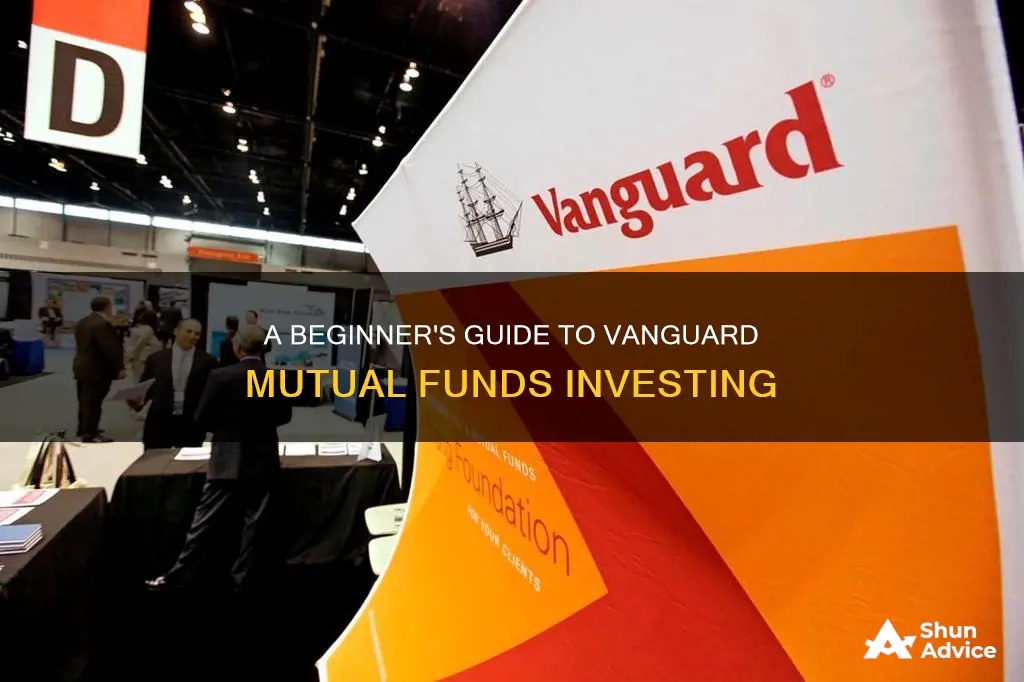
Investing in mutual funds is a great way to meet your financial goals. Vanguard is one of the largest and most well-respected investment firms in the U.S., offering over 130 mutual funds with relatively low costs. Vanguard's average expense ratio is 0.10% compared to the industry average of 0.57%. Vanguard's mutual funds are also known for their strong performance and market diversification. To start investing in Vanguard mutual funds, you can open a brokerage account with Vanguard online, buy Vanguard mutual funds in your retirement plan, or open an online brokerage account with another company. Before investing, it's important to understand the basics of risk and return, set financial goals, and determine your risk tolerance and time horizon.
| Characteristics | Values |
|---|---|
| Investment goal | Retirement, house, child's education, etc. |
| Investment type | Mutual funds, exchange-traded funds (ETFs), stocks, bonds |
| Investment account | 401(k), IRA, 529 plan, brokerage account |
| Asset allocation | Stocks, bonds, cash |
| Investment management strategy | Self-directed, robo-advisor, financial advisor |
| Investment costs | Annual fees, transaction fees, expense ratios |
| Investment risks | Loss of money, volatility, inflation |
| Initial investment | $1,000 - $50,000 |
What You'll Learn

Understand the basics of risk and return
Risk and return are two fundamental concepts in investing. Understanding them is crucial before you start investing in Vanguard mutual funds or any other investment product. Here's a detailed guide to help you understand the basics of risk and return:
Understanding Risk
Risk refers to the possibility that an investment will lose value or fail to generate the expected returns. Before investing, it's essential to assess your risk tolerance and risk capacity. Risk tolerance is your willingness to take on investment risk and your comfort level with market volatility and potential losses. It's influenced by your personal preferences and financial situation. Some investors are comfortable with higher risk in pursuit of higher returns, while others prefer lower risk and are willing to accept potentially lower returns. Risk capacity, on the other hand, is the amount of investment risk you can afford to take. It's determined by your financial situation and future financial needs. If you have a higher risk capacity, you can potentially afford to take on more risk, as you have the means to recover from potential losses.
Understanding Return
Return, or reward, is the profit or gain you can expect to make on your investment. It's important to understand that return is typically correlated with risk – higher potential returns usually come with higher risk, and lower risk investments may result in lower returns. Mutual funds, like any other investment, cannot guarantee returns or protect against losses. Vanguard, for instance, states that "all investing is subject to risk, including the possible loss of the money you invest."
Risk and Return in Mutual Funds
Mutual funds are a popular investment choice as they offer instant diversification, which helps to lower risk. By pooling your money with other investors, a mutual fund can invest in hundreds or even thousands of individual securities. So, if one security performs poorly, the others can offset its losses. This diversification benefit is a key feature of mutual funds. Additionally, mutual funds are professionally managed, meaning experts research and select the securities for you.
Different Types of Mutual Funds and Their Risks
There are two main types of mutual funds: actively managed funds and passively managed funds (also known as index funds). Actively managed funds aim to outperform a benchmark index, requiring more trades and resulting in higher fees. The minimum investment for most Vanguard actively managed funds is $50,000. On the other hand, index funds aim to match the performance of a market index, like the S&P 500 or Dow Jones Industrial Average. They generally have lower fees and fewer trades. For most Vanguard index funds, the minimum investment is $3,000.
Other Factors Affecting Risk and Return
When investing in mutual funds, it's important to consider other factors that can influence risk and return. These include your investment goals, time horizon, and asset allocation. Your investment goals and time horizon will help you determine the appropriate mix of stocks, bonds, and cash in your portfolio. A longer time horizon may allow you to take on more risk, as you have more time to recover from potential losses. Additionally, asset allocation, or the mix of investment types in your portfolio, can impact your overall risk and return. A well-diversified portfolio with different asset classes, sectors, and geographical regions can help reduce risk and improve your chances of achieving your investment goals.
Managed Funds: Choosing and Investing in a Smart Way
You may want to see also

Choose an investment account
Choosing an investment account is an important step in investing in Vanguard mutual funds. The type of account you open will depend on several factors, including your investment goals and overall financial situation. Understanding your investment goals is crucial as certain accounts are geared towards specific objectives and may have different tax implications or penalties. Here are some common types of investment accounts to consider:
General Investing Brokerage Account:
This is a taxable investment account that allows you to buy and sell a variety of investments such as individual stocks, bonds, and funds. Brokerage accounts offer more control over your investments but you may owe taxes when selling investments that have increased in value. Vanguard offers a range of brokerage accounts with low fees and no minimum investment requirements for some funds.
Retirement Accounts:
Vanguard offers various retirement account options, including Individual Retirement Accounts (IRAs). IRAs are powerful tax-advantaged accounts designed for retirement savings. You can choose between a traditional IRA, where your earnings grow tax-deferred, or a Roth IRA, which offers tax-free growth. Additionally, you can consider a 401(k) plan if your employer offers one. This allows you to save a portion of your paycheck before taxes, and your employer may even match your contributions.
Education Savings Accounts:
If you're saving for a child's education, a 529 plan is a tax-advantaged option. It offers flexibility in using the funds for various education-related expenses and can be transferred to another qualified family member. Contributions may be state tax-deductible, and you benefit from tax-deferred growth and tax-free withdrawals for qualified education expenses.
Other Account Types:
Depending on your specific goals and circumstances, you may also consider other types of accounts such as a solo 401(k), SEP IRA, SIMPLE IRA, UGMA/UTMA, or even a regular savings account. Each account type has its own advantages and tax implications, so it's important to understand your goals and seek appropriate advice before deciding.
Remember, the choice of investment account depends on your unique situation and objectives. Take the time to understand the different accounts available and how they align with your financial goals to make an informed decision.
A Guide to Investing in India's IT Index Funds
You may want to see also

Learn about asset allocation
Asset allocation is a key part of investing in Vanguard mutual funds. It's important to understand what it is and how it works before you begin.
Asset allocation refers to the mix of stocks, bonds, and cash in your investment portfolio. This mix is important because it determines the level of risk you're taking on and the potential returns you can expect. Getting the right balance is crucial to achieving your financial goals.
There are several types of assets that can be included in your portfolio:
- Stocks: When you buy stocks, you're purchasing a small piece of a company, and you're entitled to a share of the company's profits. Stocks are typically riskier than bonds but offer the potential for higher returns.
- Bonds: When you buy a bond, you're loaning money to a company or government, which pays you back with interest over time. Bonds are generally safer than stocks but tend to generate lower returns.
- Cash: Cash and cash equivalents, such as savings accounts or money market funds, are the lowest-risk asset class. They are highly liquid, meaning they can be easily accessed and are designed not to incur significant losses.
- Real estate: This tangible asset can generate income or long-term appreciation. However, it's relatively illiquid, so it can be difficult to sell quickly.
- Commodities: These are raw materials like oil, gold, or wheat. They can be a volatile asset class but offer diversification benefits.
When allocating assets, it's essential to consider your goals, time frame, and risk tolerance. If you're saving for retirement, for example, you might have a longer time horizon and be able to handle more volatile investments. On the other hand, if you're saving for a short-term goal like buying a house, you might choose more conservative investments like bonds or cash.
Vanguard offers various asset allocation funds, such as Target-Date Funds, Balanced Funds, Growth Funds, and Income Funds, each with a different mix of assets to match your goals and risk tolerance. These funds are designed to simplify your investment strategy and help you manage risk effectively.
Remember, asset allocation is a critical step in investing, and it's important to do your research and understand the basics before diving in.
Maximizing SRS Funds: Strategies for Smart Investments
You may want to see also

Explore Vanguard's different mutual funds
When exploring Vanguard's different mutual funds, it is important to understand the basics of risk and return, asset allocation, and diversification. Vanguard offers a wide range of mutual funds with different investment goals, including:
- Money market funds: These are relatively low-risk investments that focus on short-term securities issued by government agencies and corporations. They provide stable returns with lower risk compared to other funds.
- Bond funds: Bond funds have a higher risk-return profile than money market funds but can provide stability and diversification to your portfolio. They are often used to supplement stock investments.
- Stock funds: Vanguard offers stock funds that allow you to invest in domestic or international companies across different industries and sizes. This provides exposure to a diverse range of businesses and sectors.
- Target date funds: These funds invest in a mix of stocks, bonds, and other securities. As the target date approaches, the fund adjusts its asset allocation to become more conservative, reducing risk for investors. This type of fund is suitable for those saving for retirement or other long-term goals.
- Index funds: Vanguard is known for offering index funds, which are passively managed to match the performance of a specific market index, such as the S&P 500 or Dow Jones Industrial Average. These funds have lower fees than actively managed funds.
- Actively managed funds: These funds aim to outperform the market and are managed by fund managers who handpick investments based on specific criteria. They tend to have higher fees and more trades due to their active management approach.
Vanguard also offers ESG (environmental, social, and governance) funds, which allow investors to align their investments with their personal values and preferences.
When deciding which Vanguard mutual fund to choose, consider your financial goals, risk tolerance, time horizon, and investment account type. Each fund has different minimum investment requirements, fees, and risk profiles, so it is important to review the fund profiles and select the funds that align with your investment strategy and goals.
Mutual Funds: A Smart Investment Choice for Beginners
You may want to see also

Decide how much to invest
When deciding how much to invest in Vanguard mutual funds, there are several factors to consider. Firstly, it's important to understand the basics of risk and return. Different types of investments carry different levels of risk, and it's crucial to assess your own risk tolerance before making any decisions. Ask yourself how much market volatility and potential loss you're willing to accept. Your risk tolerance will likely vary depending on your time horizon, or investment duration. For example, if you have a long-term investment goal, such as saving for retirement, you may be comfortable taking on more risk as you have more time to recover from potential losses. On the other hand, if you're saving for a short-term goal, such as a house deposit, you may want to take on less risk to avoid significant losses close to the purchase date.
Another factor to consider is your financial situation. Evaluate your monthly expenses and determine how much money you can realistically put towards your investments. It's important to remember that you don't need a large sum of money to start investing. Vanguard offers a range of investment options with low minimum requirements. For example, most Vanguard mutual funds have a $3,000 minimum, but you can invest in a Vanguard Target Retirement Fund or Vanguard STAR® Fund with just $1,000. Additionally, the minimum investment for Vanguard ETFs is only $1.
When deciding how much to invest, it's crucial to align your investment amounts with your financial goals. For example, if you're saving for retirement, you'll likely need to invest a larger sum of money over a longer period. On the other hand, if you're investing for a shorter-term goal, such as a house deposit, you may only need to invest for a few years.
It's also worth considering the potential impact of compound interest. Compound interest is when the returns on your investment generate their own earnings. The longer your investment durations, the more your assets can compound and grow. Therefore, it's beneficial to start investing early and allow your money more time to grow.
Finally, don't forget to take into account the costs associated with investing, such as fees and expense ratios. These costs can chip away at your investment returns over time, so it's important to choose investment options with low fees and expenses, such as those offered by Vanguard. By choosing a low-cost provider, you can keep more of your money invested and potentially increase your returns.
A Guide to Investing in BDO Mutual Funds
You may want to see also
Frequently asked questions
A mutual fund is a collection of investors' money that fund managers use to invest in stocks, bonds, and other securities. Mutual funds are a way to instantly diversify your portfolio because they typically invest in a range of companies and industries at once.
Opening a Vanguard investing account is free and easy. It should only take around 5-10 minutes. Start by choosing "Open an account" from the menu, then select "Start your new account." Most investors fund their new accounts with an electronic bank transfer, so have your bank account and routing numbers ready.
Vanguard offers a range of investment accounts, including general investing, retirement, and higher-education savings. You can also open a brokerage account, which gives you more control over your investments.
The minimum initial investment for Vanguard Target Retirement Funds and the Vanguard STAR Fund is $1,000. A $3,000 minimum applies to most other funds. However, you can start investing with Vanguard with as little as $1, which is the minimum investment for Vanguard ETFs.
When evaluating mutual funds, consider your risk tolerance and financial goals. Once you've determined how much risk you're comfortable with, pick a mutual fund that meets your needs. For example, if you're a recent college graduate, you might choose a target-date fund that is more aggressively invested in stocks, as you have more time to invest.







